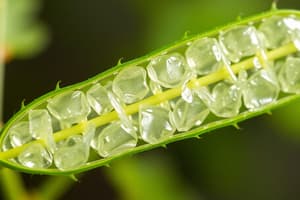Podcast
Questions and Answers
What is the immediate outcome of photon emission in the context of photosynthesis?
What is the immediate outcome of photon emission in the context of photosynthesis?
- Emission of longer wavelength light (correct)
- Formation of carbohydrates
- Absorption of energy
- Production of oxygen
Where do the light-dependent reactions occur in the chloroplast?
Where do the light-dependent reactions occur in the chloroplast?
- Stroma
- Cytoplasm
- Granum
- Thylakoid membranes (correct)
Which process involves the direct use of light energy to convert it into ATP and NADPH?
Which process involves the direct use of light energy to convert it into ATP and NADPH?
- Light-dependent reactions (correct)
- Dark reactions
- Light-independent reactions
- Calvin cycle
Which of the following pigments primarily absorb light energy during photosynthesis?
Which of the following pigments primarily absorb light energy during photosynthesis?
What major event occurs during the light-dependent reactions after chlorophyll a absorbs a photon?
What major event occurs during the light-dependent reactions after chlorophyll a absorbs a photon?
What is released as a by-product during the light-dependent reactions?
What is released as a by-product during the light-dependent reactions?
Which complex is the first to act when the light-dependent reactions begin?
Which complex is the first to act when the light-dependent reactions begin?
In which part of the chloroplast do the light-independent reactions take place?
In which part of the chloroplast do the light-independent reactions take place?
What is the final electron acceptor in the electron transport chain during photosynthesis?
What is the final electron acceptor in the electron transport chain during photosynthesis?
Which complex transfers electrons from Photosystem II to Photosystem I?
Which complex transfers electrons from Photosystem II to Photosystem I?
What is generated by the oxidation of water in Photosystem II?
What is generated by the oxidation of water in Photosystem II?
What role does ATP synthase play in photosynthesis?
What role does ATP synthase play in photosynthesis?
Which of the following statements about Photosystem I is true?
Which of the following statements about Photosystem I is true?
What phenomenon occurs when electrons flow through the electron transport chain?
What phenomenon occurs when electrons flow through the electron transport chain?
What is the function of ferredoxin in photosynthesis?
What is the function of ferredoxin in photosynthesis?
Which process creates a proton gradient used by ATP synthase?
Which process creates a proton gradient used by ATP synthase?
What is the main function of photosynthesis in plants?
What is the main function of photosynthesis in plants?
In oxygenic photosynthesis, which molecule is reduced?
In oxygenic photosynthesis, which molecule is reduced?
Which type of photosynthesis is used by purple bacteria?
Which type of photosynthesis is used by purple bacteria?
What do chloroplasts store that is essential for photosynthesis?
What do chloroplasts store that is essential for photosynthesis?
Which process results in the evolution of molecular oxygen?
Which process results in the evolution of molecular oxygen?
Which organelle contains thylakoids as structural units of photosynthesis?
Which organelle contains thylakoids as structural units of photosynthesis?
What is a significance of photosynthesis in terms of atmospheric gases?
What is a significance of photosynthesis in terms of atmospheric gases?
What do leucoplasts primarily store?
What do leucoplasts primarily store?
What enzyme is responsible for cleaving sedoheptulose-1,7-bisphosphate into sedoheptulose-7-phosphate?
What enzyme is responsible for cleaving sedoheptulose-1,7-bisphosphate into sedoheptulose-7-phosphate?
How many molecules of G3P are converted to RuBP in the Calvin cycle?
How many molecules of G3P are converted to RuBP in the Calvin cycle?
Which molecule is produced as a competitive product during photorespiration?
Which molecule is produced as a competitive product during photorespiration?
Which of the following represents the final phosphorylated product in the regeneration phase of the Calvin cycle?
Which of the following represents the final phosphorylated product in the regeneration phase of the Calvin cycle?
What is the primary purpose of C4 carbon fixation in plants?
What is the primary purpose of C4 carbon fixation in plants?
What is the consequence of photorespiration for plants?
What is the consequence of photorespiration for plants?
What carbohydrate molecule is the precursor for the formation of xylulose-5-phosphate during the process described?
What carbohydrate molecule is the precursor for the formation of xylulose-5-phosphate during the process described?
What is the role of phosphopentose isomerase in the Calvin cycle?
What is the role of phosphopentose isomerase in the Calvin cycle?
What is the primary function of cyclic photophosphorylation?
What is the primary function of cyclic photophosphorylation?
What compound is initially split during the carbon fixation process in the Calvin cycle?
What compound is initially split during the carbon fixation process in the Calvin cycle?
Which enzyme catalyzes the reduction of 1,3-bisphosphoglycerate (1,3BPGA) during carbon reduction?
Which enzyme catalyzes the reduction of 1,3-bisphosphoglycerate (1,3BPGA) during carbon reduction?
In which phase of the Calvin cycle do the majority of the ATP and NADPH produced in the light reactions fuel chemical reactions?
In which phase of the Calvin cycle do the majority of the ATP and NADPH produced in the light reactions fuel chemical reactions?
What is the first product formed when RuBisCO catalyzes the reaction between RuBP and CO2?
What is the first product formed when RuBisCO catalyzes the reaction between RuBP and CO2?
Which process converts triose phosphate into dihydroxyacetone phosphate (DHAP) during the regeneration phase?
Which process converts triose phosphate into dihydroxyacetone phosphate (DHAP) during the regeneration phase?
What happens to the phosphate ion during the conversion of G3P and DHAP into fructose 6-phosphate?
What happens to the phosphate ion during the conversion of G3P and DHAP into fructose 6-phosphate?
Which component of the ATP synthase is located outside the membrane?
Which component of the ATP synthase is located outside the membrane?
What is the primary advantage of kranz anatomy in C4 plants?
What is the primary advantage of kranz anatomy in C4 plants?
During the C4 pathway, which enzyme is responsible for converting pyruvate to phosphoenolpyruvate (PEP)?
During the C4 pathway, which enzyme is responsible for converting pyruvate to phosphoenolpyruvate (PEP)?
What is the role of malate in the C4 pathway?
What is the role of malate in the C4 pathway?
How does the C4 pathway compare to the C3 pathway in terms of energy usage?
How does the C4 pathway compare to the C3 pathway in terms of energy usage?
Which cells in C4 plants lack grana in their chloroplasts?
Which cells in C4 plants lack grana in their chloroplasts?
What is the purpose of the low conductance boundary layer in kranz anatomy?
What is the purpose of the low conductance boundary layer in kranz anatomy?
What happens to the CO2 fixed by PEP carboxylase in the C4 pathway?
What happens to the CO2 fixed by PEP carboxylase in the C4 pathway?
Who elucidated the C4 carbon fixation pathway?
Who elucidated the C4 carbon fixation pathway?
Flashcards
Photosynthesis
Photosynthesis
The process used by plants, algae and certain bacteria to convert sunlight into chemical energy.
Oxygenic Photosynthesis
Oxygenic Photosynthesis
The most common type of photosynthesis, used by plants, algae, and cyanobacteria, where water is the primary electron donor and oxygen is produced as a byproduct.
Anoxygenic Photosynthesis
Anoxygenic Photosynthesis
A type of photosynthesis used by certain bacteria where electron donors other than water are used, and oxygen is not produced.
Chloroplast
Chloroplast
Signup and view all the flashcards
Grana
Grana
Signup and view all the flashcards
Thylakoids
Thylakoids
Signup and view all the flashcards
Stroma
Stroma
Signup and view all the flashcards
What does photosynthesis produce?
What does photosynthesis produce?
Signup and view all the flashcards
Electron Transport Chain (ETC)
Electron Transport Chain (ETC)
Signup and view all the flashcards
Photosystem II (PSII)
Photosystem II (PSII)
Signup and view all the flashcards
Cytochrome b6f Complex
Cytochrome b6f Complex
Signup and view all the flashcards
Photosystem I (PSI)
Photosystem I (PSI)
Signup and view all the flashcards
Photophosphorylation
Photophosphorylation
Signup and view all the flashcards
Cyclic Photophosphorylation
Cyclic Photophosphorylation
Signup and view all the flashcards
Non-cyclic Photophosphorylation
Non-cyclic Photophosphorylation
Signup and view all the flashcards
ATP Synthase
ATP Synthase
Signup and view all the flashcards
F1 Portion of ATP Synthase
F1 Portion of ATP Synthase
Signup and view all the flashcards
Proton-Motive Force
Proton-Motive Force
Signup and view all the flashcards
Calvin Cycle
Calvin Cycle
Signup and view all the flashcards
Carbon Fixation
Carbon Fixation
Signup and view all the flashcards
Reduction Phase in Calvin Cycle
Reduction Phase in Calvin Cycle
Signup and view all the flashcards
Regeneration Phase in Calvin Cycle
Regeneration Phase in Calvin Cycle
Signup and view all the flashcards
Enediol-Enzyme Complex
Enediol-Enzyme Complex
Signup and view all the flashcards
Transketolase
Transketolase
Signup and view all the flashcards
What is the role of Xu5P in the Calvin cycle?
What is the role of Xu5P in the Calvin cycle?
Signup and view all the flashcards
Sedoheptulose-1,7-bisphosphate (S7BP)
Sedoheptulose-1,7-bisphosphate (S7BP)
Signup and view all the flashcards
Ribose-5-phosphate (R5P)
Ribose-5-phosphate (R5P)
Signup and view all the flashcards
RuBisCO
RuBisCO
Signup and view all the flashcards
Photorespiration
Photorespiration
Signup and view all the flashcards
Oxaloacetate
Oxaloacetate
Signup and view all the flashcards
Kranz Anatomy
Kranz Anatomy
Signup and view all the flashcards
Bundle-Sheath Cells
Bundle-Sheath Cells
Signup and view all the flashcards
PEP Carboxylase
PEP Carboxylase
Signup and view all the flashcards
Malic Enzyme
Malic Enzyme
Signup and view all the flashcards
C4 Pathway
C4 Pathway
Signup and view all the flashcards
Why C4 Pathway Requires More Energy
Why C4 Pathway Requires More Energy
Signup and view all the flashcards
Chlorophyll Fluorescence
Chlorophyll Fluorescence
Signup and view all the flashcards
Phosphorescence
Phosphorescence
Signup and view all the flashcards
Light-dependent Reactions
Light-dependent Reactions
Signup and view all the flashcards
Light-independent Reactions
Light-independent Reactions
Signup and view all the flashcards
Electron Transport Chain
Electron Transport Chain
Signup and view all the flashcards
What is ATP Synthase?
What is ATP Synthase?
Signup and view all the flashcards
Study Notes
Photosynthesis Overview
- Photosynthesis is the process used by plants, algae, and some bacteria to convert light energy into chemical energy.
- This process harnesses energy from sunlight to produce carbohydrates.
- Two types of photosynthesis exist: oxygenic and anoxygenic.
Oxygenic Photosynthesis
- The most common type, found in plants, algae, and cyanobacteria.
- Light energy transfers electrons from water (H₂O) to carbon dioxide (CO₂), producing carbohydrates.
- In this process, CO₂ is reduced, and water is oxidized.
- Ultimately, oxygen (O₂) is produced along with carbohydrates.
Anoxygenic Photosynthesis
- Typically occurs in certain bacteria like purple bacteria and green sulfur bacteria.
- Uses electron donors other than water.
- Produces sulfur when hydrogen sulfide (H₂S) is used as an electron donor.
Significance of Photosynthesis
- Converts solar energy into organic matter.
- Consumes atmospheric carbon dioxide and produces oxygen.
- Maintains atmospheric oxygen levels, crucial for respiration in other living organisms.
- Provides the building blocks (carbohydrates, organic acids, proteins, etc.) for other biological molecules.
- Provides energy for various metabolic activities and movements in living organisms.
Photosynthetic Requirements
- Photosynthetic eukaryotic organisms contain plastids (organelles) in their cytoplasm.
- Plastids are surrounded by a double membrane and can contain pigments or store nutrients.
- Different types of plastids include chloroplasts (with chlorophyll), chromoplasts (with carotenoids), and leucoplasts (non-pigmented, storing starch and fat).
Chloroplast Structure
- Chloroplasts are double-membrane-bound organelles performing photosynthesis.
- The grana are the innermost portion, consisting of stacked disc-shaped thylakoid membranes.
- Thylakoids contain light-harvesting complexes where electron transfer takes place.
- The empty spaces between grana are the stroma.
Thylakoids
- The thylakoid is the structural unit of photosynthesis.
- The photosynthetic membrane is vesicular, with an outer stroma phase and an inner lumen.
- The photosynthetic membrane contains most of the pigments and proteins needed for light reactions.
Pigments
- Pigments bestow color to plants, algae, and bacteria and are crucial for trapping sunlight.
- Different pigments absorb different light wavelengths.
- Chlorophylls (a, b, and c) absorb blue and red light, carotenoids absorb bluish-green light, and phycobilins absorb light wavelengths not well absorbed by other pigments (found in cyanobacteria and red algae).
Absorption of Light Energy
- Photosynthesis is primarily driven by visible light (400-700 nm).
- Light is captured by pigment molecules (chlorophyll a and b, carotenoids) in light-harvesting protein complexes within the photosynthetic membrane.
- Light-harvesting complexes surround the reaction centers that act as antennas.
- A photon's energy is absorbed by an antenna molecule, causing a transition to an excited state.
- Excited state decays within femtoseconds (10⁻¹⁵ s) to the first excited singlet state, and energy is transferred to other nearby molecules before ending at the reaction center.
Chlorophyll Fluorescence
- Excitons (excited electrons) are converted back to photons and emitted as fluorescence (a longer wavelength).
- Used as an indicator of photosynthetic energy conversion performance in plants, algae, and bacteria.
- Fluorescence can also indicate plant stress or damage to the photosynthetic apparatus.
Chlorophyll Phosphorescence
- A type of photoluminescence related to fluorescence.
- A phosphorescent material takes time to re-emit the absorbed radiation.
- Phosphorescence involves radiative electronic transitions from triplet to ground states in pigment molecules.
Light-Dependent Reactions (Light Reactions)
- Light-dependent reactions require direct light energy and use captured light energy from chlorophyll a to make energy carrier molecules (ATP and NADPH).
- Water is split, releasing oxygen (a byproduct) during these reactions.
- This occurs on the thylakoid membranes. Major protein complexes involved: PSII, cytochrome b6f complex, PSI, and ATP synthase.
Photosystem II (PSII)
- The first protein complex in the light-dependent reactions of oxygenic photosynthesis.
- Catalyzes the capture of light photons to energize electrons.
- Electrons are transferred through various coenzymes and cofactors to reduce plastoquinone to plastoquinol.
- Water is oxidised to replenish lost electrons, releasing oxygen.
Cytochrome b6f complex
- Transfers electrons from Photosystem II to Photosystem I (PSI).
- It pumps protons into the thylakoid lumen, creating an electrochemical gradient.
Photosystem I (PSI)
- The second photosystem.
- The electron gets energy from another photon.
- The final electron acceptor is NADP+.
- This creates NADPH.
ATP Synthase
- Creates the energy storage molecule, ATP, using the proton gradient formed by the electron transport chain.
- It comprises two parts: FO embedded within the thylakoid membrane and F1 outside.
Non-cyclic and Cyclic Photophosphorylation
- Non-cyclic: the primary electron flow from PSII to cytochrome b6f then to PSI to create ATP and NADPH.
- Cyclic: ATP is produced, but no NADPH. The electron flow goes from PSII to cytochrome b6f to PSI, then back to the cytochrome b6f complex.
Calvin Cycle (Light-Independent Reactions or Dark Reactions)
- Plants and algae use the Calvin cycle to convert carbon dioxide into sugars.
- It occurs in the stroma of the chloroplasts.
- It involves four main steps: carbon fixation, reduction, carbohydrate formation, and regeneration.
- The cycle uses ATP and NADPH (created during light reactions) to fuel the reactions.
Carbon Fixation
- The enzyme RuBisCO catalyzes the carboxylation of ribulose-1,5-bisphosphate (RuBP, a 5-carbon compound) by carbon dioxide (CO₂) in a two-step reaction.
- Carbon dioxide is captured, producing a 6-carbon intermediate that then splits into two 3-carbon molecules (3-PGA).
Carbon Reduction
- Enzyme phosphoglycerate kinase phosphorylates 3-PGA using ATP, producing 1,3-bisphosphoglycerate (1,3-BPG) and ADP
- Enzyme glyceraldehyde-3-phosphate dehydrogenase catalyzes the reduction of 1,3-BPG by NADPH. This produces glyceraldehyde-3-phosphate (G3P) and oxidised NADP+.
Regeneration Phase
- Molecules involved (fructose-1,6-bisphosphate and dihydroxyacetone phosphate) in converting five G3P molecules to three 5-carbon molecules of RuBP, also using ATP.
Photorespiration
- RuBisCO sometimes reacts with oxygen (O₂) instead of carbon dioxide (CO₂), a process called photorespiration.
- It's more active at higher temperatures and involves a loss of carbon dioxide.
- The byproducts are converted into other compounds.
C4 Carbon Fixation
- Evolved to minimize photorespiration in plants in hot, dry climates.
- CO₂ is concentrated around RuBisCO, creating higher CO₂ substrate levels to reduce the competition for O₂ and CO₂ by RuBisCO.
- Involves carbon fixation in mesophyll cells followed by transport to bundle-sheath cells, concentrating CO₂ around RuBisCO.
- Multiple enzyme systems in the mesophyll and bundle sheath cells. Variations include malate or aspartate as the 4-carbon intermediates transported from mesophyll to bundle sheath.
C4 Leaf Anatomy
- Kranz anatomy: leaf structure with concentric rings of cells surrounding the vascular bundles, consisting of mesophyll and bundle sheath cells.
- Bundle sheath cells are rich in chloroplasts, often lacking grana, and have high concentration of CO₂, low O₂ levels.
C4 Pathway
- The series of reactions of C4 pathway which involves creation of 4-carbon organic acids in mesophyll cells
- These molecules then are transported to other cells for decarboxylation and carbon dioxide release to further enter Calvin Cycle. This pathway is used by tropical and warm climate plants.
CAM (Crassulacean Acid Metabolism)
- Plants use this pathway to minimize water loss in hot, dry environments.
- Carbon dioxide is fixed at night when stomata are open, during this time it is converted into organic acids (such as malate) and stored in vacuoles. During the day the stomata are closed, organic acids release carbon dioxide for further use in Calvin Cycle.
Studying That Suits You
Use AI to generate personalized quizzes and flashcards to suit your learning preferences.




